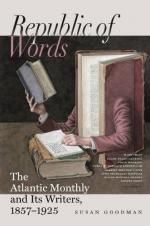Sometimes, indeed, a daring romance-writer ventures, during the earlier chapters of his story, to represent a heroine without beauty and without wealth, or a hero with some mortal blemish. But after a time his resolution fails;—each new chapter gives a new charm to the ordinary face; the eyes grow “liquid” and “lustrous,” always having been “large”; the nose, “naturally delicate,” exhibits its “fine-cut lines”; the mouth acquires an indescribable expression of loveliness; and the reader’s hoped-for Fright is transformed by Folly or Miss Pickering into a commonplace, tiresome, novelesque Beauty. Even Miss Bronte relented toward Jane Eyre; and weaker novelists are continually repeating, but with the omission of the moral, the story of the “Ugly Duck.” Unquestionably, there is the excuse to be made for this great error, that it betrays the seeking after an Ideal. Dangerous word! The ideal standard of excellence is, to be sure, fortunately changing, and the unreal ideal will soon be confined to the second-rate writers for second-rate readers. But all the great novelists of the two last generations indulged themselves and their readers in these unrealities. It is vastly easier to invent a consistent character than to represent an inconsistent one;—a hero is easier to make (so all historians have found) than a man.
Suppose, however, novelists could be placed in a society made up of their favorite characters,—forced into real, lifelike intercourse with them;—Richardson, for instance, with his Harriet Byron or Clarissa, attended by Sir Charles; Miss Burney with Lord Orville and Evelina; Miss Edgeworth with Caroline Percy, and that marvellous hero, Count Altenburg; Scott with the automatons that he called Waverley and Flora McIvor. Suppose they were brought together to share the comforts (cold comforts they would be) of life, to pass days together, to meet every morning at breakfast; with what a ludicrous sense of relief, at the close of this purgatorial period, would not the unhappy novelists have fled from these deserted heroes and heroines, and the precious proprieties of their romance, to the very driest and mustiest of human bores,—gratefully rejoicing that the world was not filled with such creatures as they themselves had set before it as ideals!
To copy Nature faithfully and heartily is certainly not less needful when stories are presented in words than when they are told on canvas or in marble. In the “Scenes from Clerical Life” we have a happy example of such copying. The three stories embraced under this title are written vigorously, with a just appreciation of the romance of reality, and with honest adherence to truth of representation in the sombre as well as the brighter portions of life. It demands not only a large intellect, but a large heart, to gain such a candid and inclusive appreciation of life and character as they display. The greater part of each story reads like a reminiscence




